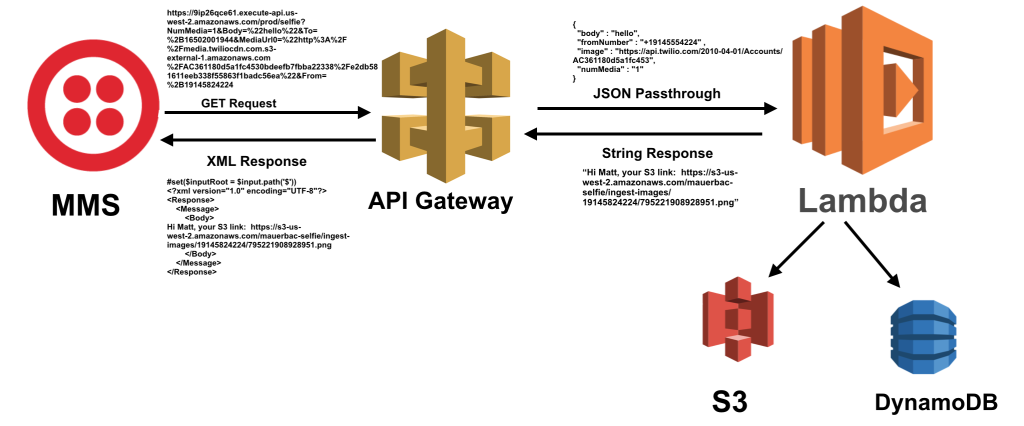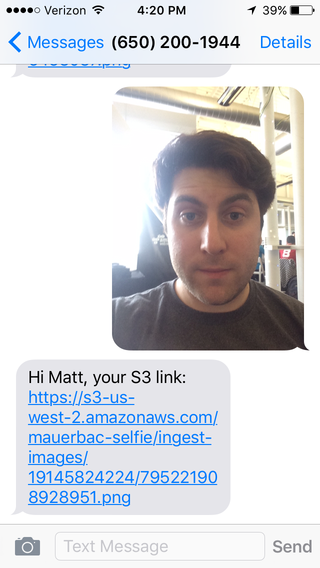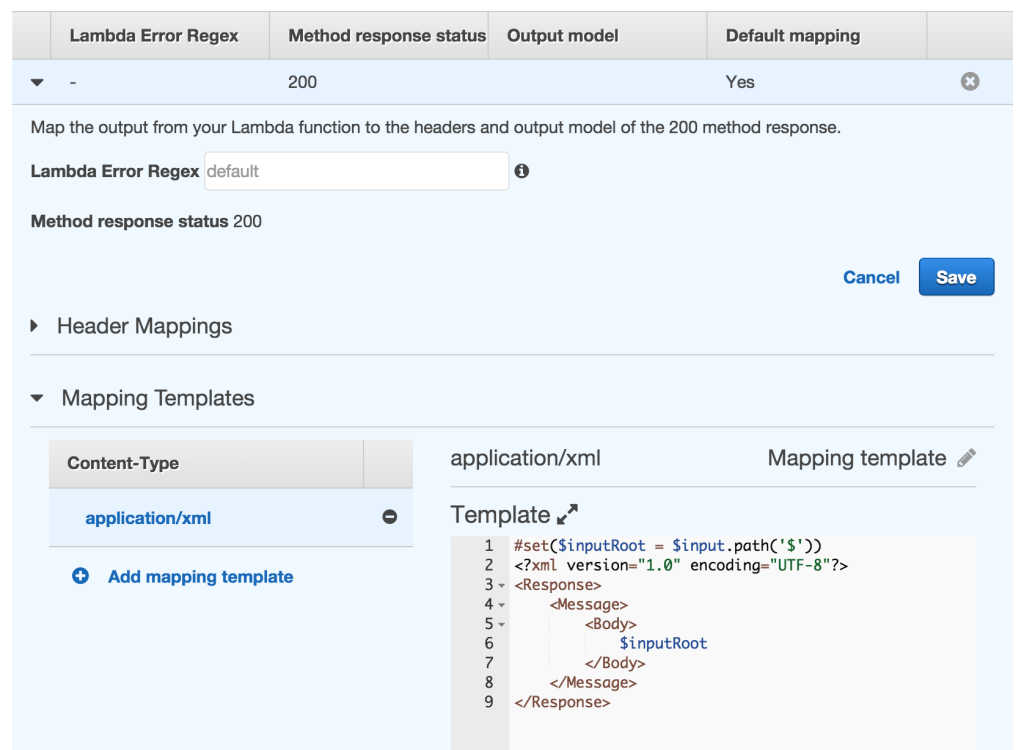Sending Selfies Without Servers: How To Use Twilio MMS, Amazon Lamba, and Amazon’s API Gateway
Time to read:

We’d be in a much different world if setting up backend servers was as easy as taking a selfie. In that world, you’d be watching your favorite band play as someone hoists their computer in the air, blocks the band, and configures the backend of their app. Of course, that world is fantasy. But, serverless MMS apps are a reality thanks to some slick work from Matt Auerbach.
With the newly announced Amazon Lambda, you can let your code run free without setting up servers. Using his newly found freedom, Matt set up a Twilio MMS app that writes to an S3 bucket, and then triggers a response from Twilio to the selfie sender.
Without further adieu let’s get to building. You can view Matt’s post originally published on GitHub here.
Here’s what the architecture looks like.

Lambda + API Gateway Example
This example uses Twilio to save an image from your mobile phone to the AWS cloud. A user sends an image using MMS to a Twilio phone number which sends a request to an Amazon API Gateway endpoint that triggers a Lambda function. The app then returns a publicly accessible link to the image in AWS S3. This app uses AWS Lambda, API Gateway, DynamoDB & S3. It is also 100% serverless!
AWS Lambda
Lambda is a compute service that runs your code in response to events. Events are triggered or invoked by resources in your AWS environment or via API Gateway. Here our Lambda function is triggered by an API Gateway endpoint that Twilio hits after an MMS is received. The Lambda function is responsible for writing user info to DynamoDB, writing the image to S3 with meta data and returning a response to Twilio.
Amazon API Gateway
API Gateway is a fully managed API as a service where you can create, publish, maintain, monitor, and secure APIs at any scale. In this app, we use API Gateway to create an endpoint for Twilio to make a GET request. API Gateway transforms Twilio’s URL encoded request into a JSON object, so that Lambda can process it. Lastly, API Gateway takes Lambda’s response and builds an XML object for Twilio.
Amazon DynamoDB & Amazon S3
DynamoDB is Amazon’s non-relational database service. This app leverages DynamoDB to store user data. S3 provides developers with object level storage that is endlessly scalable. We use S3 to store images received via MMS.
Usage

S3 Link
Building the App
Step-by-step on how to configure, develop & deploy this app on AWS.
Housekeeping
- Sign-in to AWS or Create an Account.
- Pick a region in the console and be consistent throughout this app. Use either us-east-1, us-west-2 & eu-west-1.
- Create a table in DynamoDB with a single Hash for primary key of type String. We don’t need any additional indexes and you can keep the read/write capacity at 1 for this example. Screenshot
- Create an S3 bucket to ingest MMS images. Ex. mauerbac-ingest
- Create an IAM role with access to the S3 bucket & the DynamoDB table.
- Create/login to a Twilio account & create a phone number with MMS capability.
Lambda
- Create a new Lambda function. I’ve provided the function, so we can skip a blueprint.
- Give it a name and description. Use Python 2.7 for runtime.
- Use the given Lambda function, lambda_function.py. Read through the module and provide a few variables: Twilio credentials, DynamoDB table name & region and S3 ingest bucket. We will upload as a .zip because our function requires a few external libraries, such as Twilio Python SDK. Compress httplib2, pytz, twilio & lambda_function.py and upload as a .zip file.
- The Lambda function handler tells Lambda what .py module to use and corresponding method. Ex. main_function.lambda_handler would call the method def lambda_handler() inside main_function.py. Let’s call it lambda_function.lambda_handler to match lambda_function.py.
- Select the role we created earlier in the housekeeping steps.
- In advanced settings, I recommend changing Timeout to 10 seconds (httplib2 is a bit needy). Currently, max timeout is 60 seconds.
- Review & create function.
API Gateway
- Create a new API. Give it a name and description. This will be our RESTful endpoint.
- Create a resource. The path should be /addphoto , for example.
- We need to add a method to this resource. Create a GET method with Lambda integration and select the function we created earlier. API Gateway isn’t able to process POST requests that are URL encoded, so we are using GET as a workaround.
- Now let’s setup the Integration Request. Twilio’s GET request will be of type application-x-www-form-urlencoded. This Integration step will map this type to a JSON object, which Lambda requires. In the Integration Requests page create a mapping template. Content-type is application/json and template:
More on Intergration Requests.
$input.params() parse the request object for the corresponding variable and allows the mapping template to build a JSON object. Screenshot
5. Let’s ensure the response is correct. Twilio requires valid XML. Change the response model for 200 to Content-type:
application/xml. Leave models empty. Screenshot
6. Lambda cannot return proper XML, so API Gateway needs to build this. This is done in Integration response as another mapping template. This time we want to create Content-type: application/xml and template:
Our Lambda function solely returns a string of the SMS body. Here we build the XML object and use
$inputRoot as the string. Here’s what that looks like.

7. Now let’s deploy this API, so we can test it! Click the Deploy API button.
Connecting The Dots & Testing
- We should now have a publicly accessible GET endpoint. Ex: https://xxxx.execute-api.us-west-2.amazonaws.com/prod/addphoto
- Point your Twilio number to this endpoint.

- Our app should now be connected. Let’s review: Twilio sends a GET request with MMS image, fromNumber and body to API Gateway. API Gateway transforms the GET request into a JSON object, which is passed to a Lambda function. Lambda processes the object and writes the user to DynamoDB and writes the image to S3. Lambda returns a string which API Gateway uses to create an XML object for Twilio’s response to the user.
- First, let’s test the Lambda function. Click the Actions dropdown and Configure sample event. We need to simulate the JSON object passed by API Gateway. Example:
Click Test. At the bottom of the page you view Execution result and the log output in Cloudwatch logs. This is very helpful for debugging.
- Testing API Gateway requires a client that sends requests to the endpoint. I personally like the Chrome Extension Advanced Rest Client Send the endpoint a GET request and view its response. Ensure the S3 link works. You can also test by sending an MMS to phone number and checking the Twilio logs.
Troubleshooting
- Ensure your Lambda function is using the correct IAM role. The role must have the ability to write/read to DynamoDB and S3.
- All Lambda interactions are logged in Cloudwatch logs. View the logs for debugging.
- Lambda/API Gateway Forums
Architecture

Related Posts
Related Resources
Twilio Docs
From APIs to SDKs to sample apps
API reference documentation, SDKs, helper libraries, quickstarts, and tutorials for your language and platform.
Resource Center
The latest ebooks, industry reports, and webinars
Learn from customer engagement experts to improve your own communication.
Ahoy
Twilio's developer community hub
Best practices, code samples, and inspiration to build communications and digital engagement experiences.
